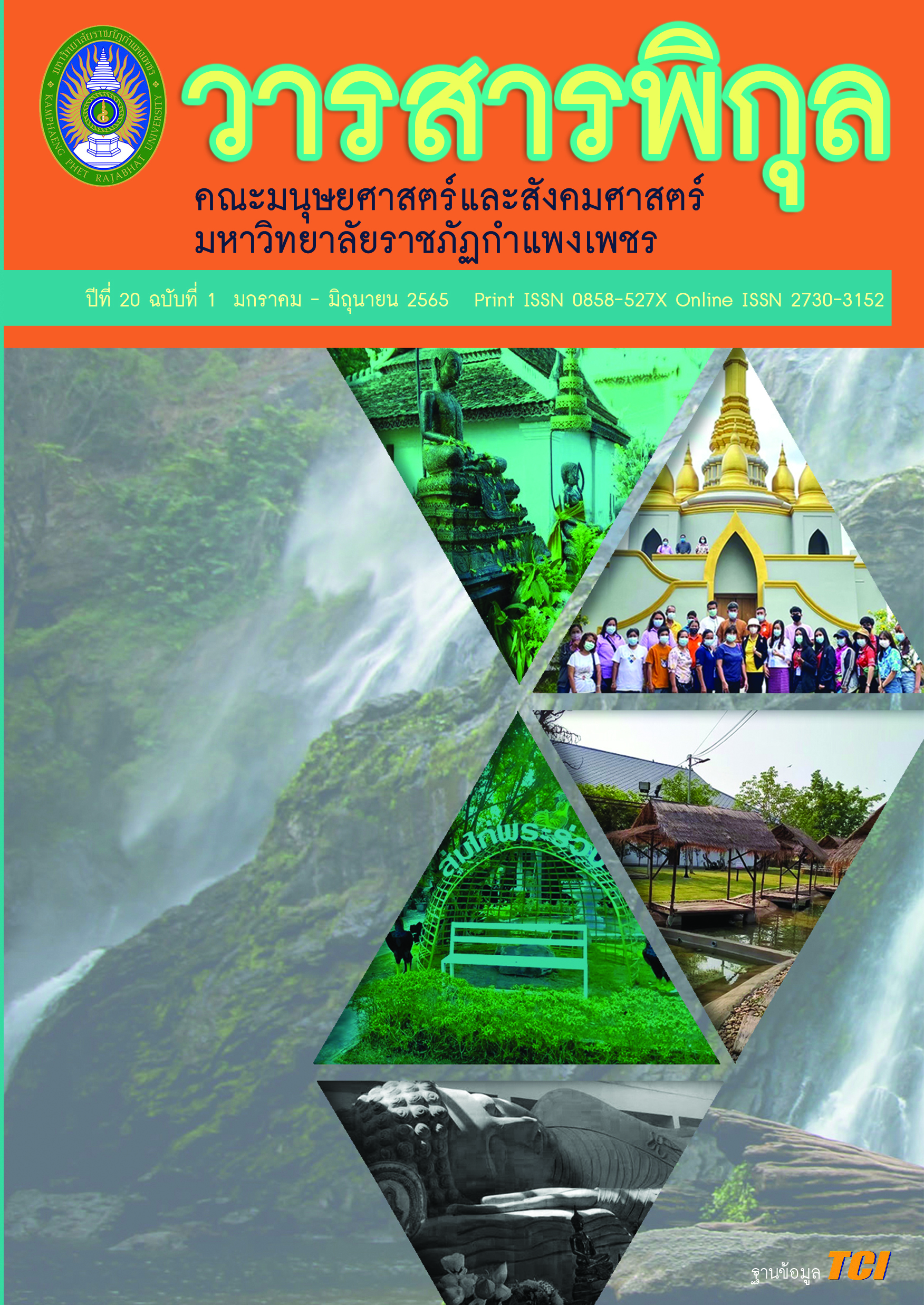Potential Development in Community Tourism Attractions in Landokmai Sub-district, Kamphaeng Phet Province
Main Article Content
บทคัดย่อ
ABSTRACT
Guidelines for Potential Sustainable Community Tourism Development consist of culture, identity, nature, strong community, self-management, good hospitality, and professional leadership as well as government sector support. This research aimed to study potential tourism attractions in Landokmai Sub-district and to find out the guidelines for the potential development of tourism attractions in Landokmai Sub-district and the results of using these guidelines for the potential development of tourism attractions in Landokmai Sub-district, Kamphaeng Phet Province, Thailand. This qualitative and quantitative research employed mixed methods, including a semi-structured interview, a community survey, a focus group discussion, and questionnaires. The analysis was separated into two parts: researchers and questionnaires. The key informants were the leaders of the villages or communities, the representatives of the communities, and the people in the communities, consisting of 110 people from 11 communities in Landokmai Sub-district. The research tool was a community tourism potential assessment to enter the community tourism certification process of special Designated Areas for Sustainable Tourism Administration (Public Organization) (DASTA), Sukhothai area. The data collected was analyzed by means of percentage, frequency, and standard deviation. Content analysis was also applied.
The results showed that (1) the potential tourist attractions in the social and cultural dimension were associated with a strong community and culture of local wisdom of foods and (2) the guidelines for potential development of tourism attractions in Landokmai Sub-district, including people, communities, and government sections will help collaborative learning for tourism sustainability. The community available dimension is related to the local wisdom of food and identities. In addition, the natural resources dimension is connected to the sufficiency economy philosophy. Here, the community organization gave the opinions that all were associated with the communities’ participation. In terms of the location dimension, it had distinct of the nature and the ability to easily access dimension which was comfortable to link with the main route of tourism attractions. The opportunity for development dimension was related to the local wisdoms, cultures, resources, and government section. The marketing and management for tourism dimension got the guidelines for running the plan in Landokmai local government administration. Finally, using the guidelines for the potential development of tourism attractions in Landokmai Sub-district resulted in 16 guidelines for tourism community plan into the main plan of Local government administration and they can be used as a framework for sustainable tourism community management.
Article Details

อนุญาตภายใต้เงื่อนไข Creative Commons Attribution-NonCommercial-NoDerivatives 4.0 International License.
เนื้อหาและข้อมูลในบทความที่ลงตีพิมพ์ในวารสารพิกุล ถือเป็นข้อคิดเห็นและความรับผิดชอบของผู้เขียนบทความโดยตรงซึ่งกองบรรณาธิการวารสาร ไม่จำเป็นต้องเห็นด้วย หรือร่วมรับผิดชอบใด ๆ
บทความ ข้อมูล เนื้อหา รูปภาพ ฯลฯ ที่ได้รับการตีพิมพ์ในวารสารพิกุล ถือเป็นลิขสิทธิ์ของวารสารพิกุล หากบุคคลหรือหน่วยงานใดต้องการนำทั้งหมดหรือส่วนหนึ่งส่วนใดไปเผยแพร่ต่อหรือเพื่อกระทำการใด ๆ จะต้องได้รับอนุญาตเป็นลายลักอักษรจากวารสารพิกุล ก่อนเท่านั้น
เอกสารอ้างอิง
Berger, P. L. & Luckmann, T. (1967). The Social Construction of Reality A Treatise in the Sociology of Knowledge. German: The Penguin Press, Published in Penguin.
Jenkins, R. (1996). Social Identity. Fourth edition. London and Newyork: Routledge Taylor & Francis Group.
Jittangwattana, B. (2006). Sustainable Tourism Development. Bangkok: Press & design.
Jirinang, P. (2016). Guidelines to Develop the Tourism Potential of Kanchanaburi. Western University Research Journal of Humanities and Social Science. Vol. 1, No.1 January - April 2015: ISSN 2465-3578.
Kawinweerakul, K. (2018). Anthropology of tourism: A theoretical framework and its contributions. thaijo, 36(2) https://www.tci-thaijo.org/index.php/huru/article/view/123638.
Kullachai, K., Kullachai, P., & Nipitwittaya S. (2559). The Created Guidebook Model for Thai Phuan Community Based Tourism by Community Participation Kahowai Sub-District, Pakplee District, Nakornnayok Province. http://ejournals.swu.ac.th/index.php/JOS/article/viewFile/8189/7245.
_______. The community tourism potential assessment to enter the community tourism certification process of special Designated Areas for Sustainable Tourism Administration (Public Organization) (DASTA).
Likert, Rensis A. (1961). Retrieved February 15, 2018 from https://en.wikipedia.org/wiki/Likert_scale.
Macannell, D. (1976). Authenticity and commoditization in tourism. Annals of Tourism Research 15(3) 371-386.
Min., A.M. (2015). Rakhine migrant factory workers' social network in Hlaing Tharyar Industrial Zone in Yangon, Myanmar (Unpublished master's thesis). Chiang Mai, Thailand: Chiang Mai University. [in Thai].
Prastio, B., Nurzafira, I., Ibrahim, A. S., Susanto, G., Roekhan, R. (2020). The use of illocutionary speech acts in colloquial by Anak Dalam Jambi Tribe. Journal Arbitrer, 7(2), 109–117. doi: 10.25077/ar.7.2.109-117.2020.
Lenzerini, F. (2011). Intangible cultural heritage: The living culture of peoples. European Journal International Law, 22(1), 101–120. doi: 10.1093/ejil/chr006.
Richards, G. (2001). Creating a New Tourism? In tourism I culture : Debats del Congres de Turisme Cultural, Interarts Foundation, Barcelona.
Rodtassana, W. (2014). Cultural tourism management of the Thai Puan Group: A case study of Talad Gao Hong Community, Bang Pla Ma, Suphanburi (Unpublished master's thesis). Dhurakij Pundit University, Bangkok, Thailand. [in Thai] Sukhothai Retrieved October 30,2017from http://tis.dasta.or.th/dasta_survey/new/tourist/evaluatio).
Wisuthilak, S. (2017). Heritage of the Nations: lessons learned from the neighboring countries. Bangkok, Thailand: Princess Maha Chakri Sirindhorn Anthropology Centre (Public Organization). Retrieved from https://www.sac.or.th/th/wp-content/uploads/woocommerce_uploads/2017/08/Heritage-book10.08.17.pdf [in Thai]
Tabsirak, A. (2012). Potential Development of Cultural Tourism Management of the Nyah Kur Ethnic Group Thep Sathit District, Chaiyaphum Province. Independent Study Report for the Master of Business Administration in Tourism Management. Graduate School, Khon Kaen University.
Tongpeng, J. (2011). Opinions of tourists toward cultural tourism of Wat Sotornwararamwihan, Chacherngsao (Unpublished master's thesis). Burapha University, Chonburi, Thailand. [in Thai]
United Nations Educational, Scientific and Cultural Organization [UNESCO]. (2017). Cultural heritage and sustainable development. Bangkok, Thailand: Author. Retrieved from. https://ich.unesco.org/doc/src/34299-TH.pdf. [in Thai]
United Nations Educational, Scientific and Cultural Organization [UNESCO]. (2000). Principles and guidelines for the protection and promotion of the heritage of indigenous peoples. Geneva, Switzerland: Author. Retrieved from http://ankn.uaf.edu/iks/protect.html.


